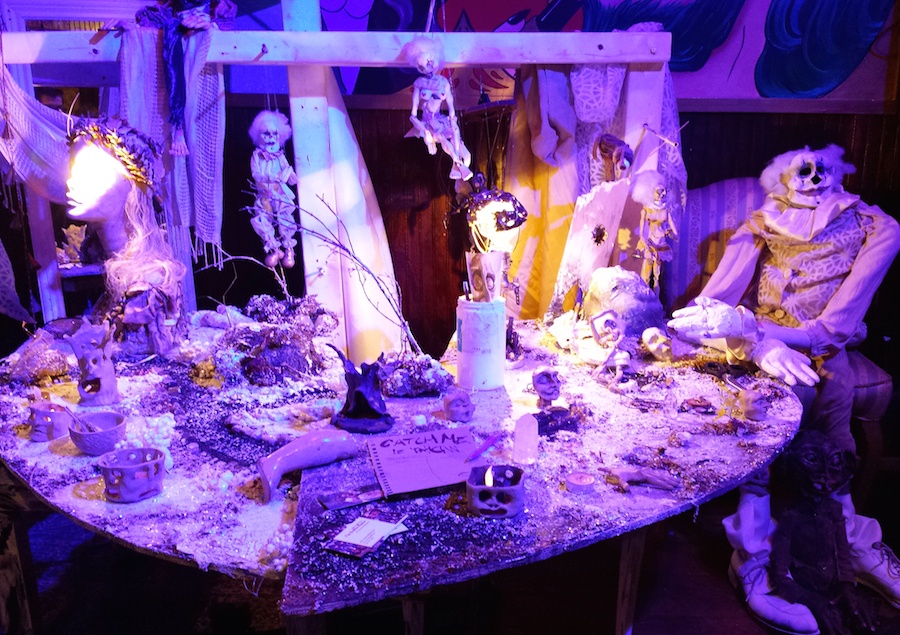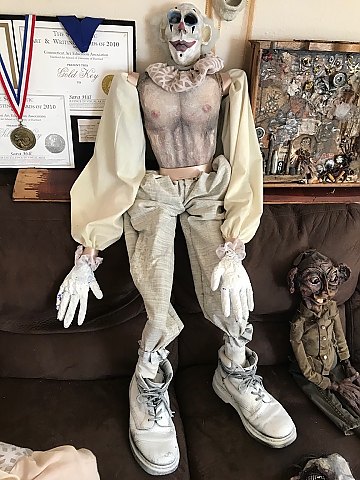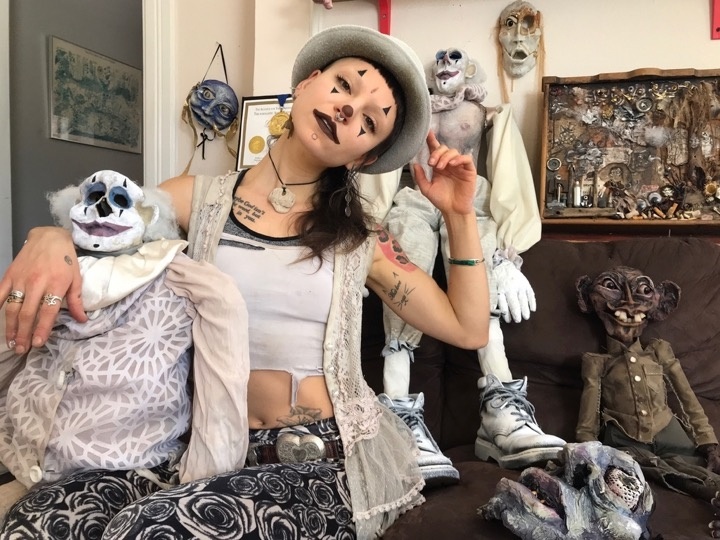
Citizen Contributions | Downtown | Sara Hope Hill | Arts & Culture | New Haven | Three Sheets New Haven | Visual Arts
 One of the installations at the event. Stephen Urchick Photo.
One of the installations at the event. Stephen Urchick Photo.
Last weekend, Sara Hope Hill put a spin on Three Sheets’ monthly series “Art In The Back, Music In The Front.” Transforming the back room and stage into an installation, Hill also added herself to the mix, in a 15-minute live puppet show between musical acts Alethea and Jacques le Coque.
The following is part critique, part report, and part citizen contribution. Excerpted from anonymous interviews done during the show and performance, it’s meant to expand The Arts Paper’s role as “the voice of the community”—by drawing directly from that community.
***
The Arts Paper: You mentioned that you were once at a clown camp and that you have a deep affection for clowning. Is there a work on the wall here that reminds you of the time you were at that camp?
Growing up—because I was part of that camp—I did see a lot of clown stuff. And at first I thought clowns were really creepy; I think that’s what I like about it now. I’ve grown to definitely have a huge affection for clowns—and masks, in general—because of commedia dell’arte, another performance art. And so, that’s what got me to come out today.
Is there a mask up on the wall, here, that gets at a commedia dell’arte feeling for you?
Yeah, actually. Um, the one that’s the highest one up on the wall.
 Sara Hope Hill Photo.
Sara Hope Hill Photo.
Why don’t we go over and look at it?
I feel like this one in particular.
—and what do you see that makes you say “that one?”
What was that?
What do you see that makes you say “that one?”
I think it’s just: the shapes of it remind me of a character—I can’t remember which character—from commedia dell’arte. It definitely has a similar vibe to it.
What shapes in particular?
Cheekbones. Which I see in a lot of these masks: pronounced cheekbones.
Are they bulging cheekbones, or narrow cheekbones?
Yeah, bulging cheekbones. And really all of the shadows and the indentations are very—like—bold. That comes out a lot in commedia dell’arte.
You said that it was reminding you of a character: What sort of role would that character play?
Well, I can’t remember, really. There’s one really creepy old character, an old man character—I can’t remember the name of. But it’s—I see, like, mixes of different characters.
Got it.
Arlecchino is, like, in a bunch of different masks, but just like little features from each. That’s where I’m falling in from.
***
Was there a work that particularly caught your eye?
Yeah. Out of the whole array, here? Number 65 Because it looks, like: Do you remember in how the 80’s any time they had some special effect, they had—like—claymation. It looks like that. Like Pee-Wee Herman, with the guy that pops out of the trunk. With the creepy face. It’s really weird. But I like it.
Tell me a little bit more. What are some of the details that remind you of claymation?
Well, it’s made of clay. But, also: It’s got that, sort of—like—pasty kind of appearance. The eyes are glossy. It’s pretty cool. This is my friend.
Hi.
Hi.
This is a reporter. He’s doing a story for the newspaper, so he’s just asking what I think of the art.
Yeah. Is it okay if I get you on this recording? We’re not going to use any names. We’re just going to put together this undifferentiated “voice of the people” to characterize the type of art that’s shared by Sara Hope Hill.
Cool!
Awesome. We were just talking about this mask over here, and how it reminds him of claymation.
It does remind me of claymation.
I was saying how—in the old 80’s movies—anytime when there’s a special effect, it’s Claymation, it’s kind of like that stuff.
Especially the eyes.
Yeah, the eyes bug out.
The eyes could move at any moment.
There’s clearly like a theme, but I don’t know what. Is it the same artist? Is it just one artist.
It’s just one artist. So, tell me a little bit more about the theme that you’re thinking of. What do you see that makes you say it’s “themed?”
They’re all just different sorts of faces. They all remind me of shrunken heads.
Yeah.
Yasss—!
Tell me a little bit more. What do you see that makes you say “shrunken heads?”
You know, well—um—the hair looks kind of dehydrated. You know: It has a scraggly, dehydrated look. Sometimes a shrunken head has curly, turned up lips. Or, they have sewn lips.
—they’re all sutured up?
Yeah, because of that the lips are a little cracked and deformed. Really: These lips remind me of that. I also like that it’s kind of scattered; it’s thrown together, but I really like it. It’s really interesting. It’s weird, but cool.
So, it’s weird and cool: but would you take it home with you? Is there a place where you would put a work like this inside of your apartment or your house?
Definitely.
Where?
Definitely. It’s a definite conversation piece. In a library.
—in the library of the house?
In the study, or an office.
And what sort of conversations would you have?
—I don’t even know! As soon as you get in there, they’d ask you where you got that: “What’s the story behind that thing?” “Oh, you know—I’m just a weird kind of dude and this is the kind of thing that I like.” And then you get drunk and stare at it and think about life.
***
Was there a particular print up on the wall that you looked at for a longer period of time than usual?
Yeah, that one right there.
What did you see that made you walk over and take a look at it?
It’s black and white. It’s line work.
What are the lines like?
Ah, they give dimension. It’s a drawing of a human body. Two human bodies. And the lines give a lot of dimension to the bodies. They’re anthropomorphic but they’re not—they’re not exact. They’re exaggerated. Yeah, the human form is exaggerated in different ways!
What do you see that makes you say it’s “exaggerated?”
Widened hips. The skeletal structure is not usual.
 Sara Hope Hill. Photo Courtesy Sara Hope Hill.
Sara Hope Hill. Photo Courtesy Sara Hope Hill.
Given that it’s been “exaggerated,” what details allow you to know that it’s still a human body?
You can tell something is human even if it’s still a stick figure. It’s a symbol that represents something. This is a little closer to human. It’s like those studies that show if you make little differences with a human face, the closer that you are to “exactness”—the smaller the differences are—the more it’s kind of creepy. I think that’s evolutionary. It’s a way of saying something isn’t healthy. They show things like decay, like bad health. There’s something special about that, because we’re not all in good health. We’re all decaying. Art offers some consolation for that human experience.
***
We were talking earlier about how this work gave you reminders of surrealist art. What did you see that made you reach for the word “surreal?”
The art connects to an artist I know from Germany. She used to do medieval scenes: faces a little bit displaced from diseases, from starvation. From all these kinds of things which we now in our modern society see as ugly, as poor, as out on the outskirts. This art, here, partially has this aspect in it. But it also shows the face’s inner, specific kind of beauty at the same time.
All the fishy eyes, on the one hand, but on the other hand, kind of, like: “Woah—yeah, yeah! That could be an actual person with their own character and their own history. Why does that person have that facial expression?” Are they going through inner struggles that then are reflected in their visual appearance?
Which makes it really surreal, because all those things exist somewhere “out there.” But due to our modern standards of beauty it feels more like dream scenes, like ancient memories which are incorporated in our connected consciousness and the collected history of how we’ve looked as humans. Ways we do not necessary look any more.
In that explanation you just gave me, you identified a couple of causes for why these faces might look the way they look. They could be diseased, starving, they could be suffering from some sort of inner struggle that manifests itself physically. Out of those three categories: What do you think some of the faces on this wall are suffering from?
Ah, okay. This one with like the fish-eyes. It’s kind of, like: “Woah. I’m seeing a lot of harm in the world. Therefore, I’m putting this inner struggle on the outside.” Like: The eyes are popping out and trying to run away from what is happening.
***
Before I jumped in, what were you guys looking at and talking about?
We were talking about how affordable everything is. Which is awesome! Because accessible art is really hard to come by sometimes. But: Sara’s stuff is really incredible. And, like, I’ve known Sara since before she started working in this medium. So, it’s been really cool to watch her trajectory—her stuff is just so cool and creepy.
What do you see that makes you say it’s “creepy?”
What was the—the smashed clown face over there? Oooh!
What makes you go “Oooh!”
I don’t know. She just has a really cool way of expressing—
It definitely feels if I just found this in my grandparents’ attic—I’m going to die in three days.
Oh, man.
Come on! If you just found this in a box? That’s definitely going to lead me to kill several people or—
Get a curse—
Yeah, they all feel like cursed items. Like: I’m moving out soon. I want to decorate my walls. I’m stoked to be here and to be looking at art with the perspective of “What creepy thing do I want to put on my wall?” I’m super hyped on that.
What wall would you put this on? What walls in your apartment or your house is the wall for one of these works?
Well, that would depend, I’m moving in with her—
Ah, it’s going to be a joint decision.
She’s had to veto a couple of things I wanted on our walls. That’s actually part of what we were talking about: “What level of creepy would you accept on the walls of our joint home?” I was like: “What about this? Would you be okay with that staring at you while you sleep?”
Did you decide?
No, but I think we just still have to look around.
She said I would just have to approve whatever decision I made. I don’t want to have to drive out to Utah to bury it in the desert or some shit.
Would you drive out to Utah to bury that clown in the desert?
If it somehow showed up in my life. If I bought it, I would be like: “This is my fault.” If it showed up in the mail one day—I’d go to Utah to bury it in the desert.
It’s like Jumanji, it just keeps coming back.
Or, I’d drive to the West Coast and throw it into the ocean and be like: “Begone!”
Is there a ratio between “creepiness” and the distance you’d drive to bury it? If you had to go to Hartford to bury something, what is a “Hartford” work on this wall?
I would bury this in my backyard and feel okay about it. Okay: The neighbor’s backyard. I’d go next door and dig a hole. Maybe it wouldn’t be that deep. I’d be like, “tsch, tsch”[digging SFX] and it would still be poking out.
What do you see that makes it more normal?
—that makes it more normal?
Yeah, that makes it safer. That makes it something that can go in your backyard.
Honestly, it’s the price. The fact that it’s $10 is—it can’t be that cursed if it’s $10.
Also, it’s not mixed media. It’s just a picture.
Something that’s expensive enough, it’s: “Oh, this belonged a f–––ing 107 year-old witch who lived in a swamp.” Like: this probably didn’t belong to a 107 year-old witch that lived in a swamp. It was probably just a picture [Sara] took and put in the frame. But, this! This is something [Sara] found from a f–––ing witch in a swamp.
What do you see that makes you say this is from a swamp witch, and not a forest witch?
I just feel that swamps scream “witch” to me. If I was going to find a witch for any reason—
—I’d check the swamp first!
I don’t trust a forest witch. If I have to curse my enemies? You’re going to go to the forest witch for that and she’s going to rip you off; you’re going to give your eyeball for nothing. You go to a swamp witch: you give some toenail clipping, they’ll f–––ing curse your enemies, or whatever.
That’s where you have to live if you’re a real witch.
Thank you guys so much for sharing. That was awesome.

